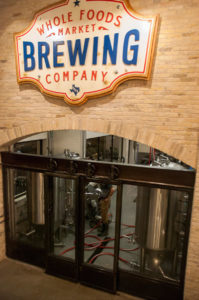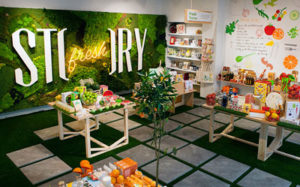 It’s a stark new reality for retailers and brands. Traditional definitions of categories can no longer dictate the shopping journey. Shoppers want solutions tailored to their lifestyles. They crave interactions, not mere transactions. In the landscape of ever-evolving physical and digital formats, driving traffic and conversion requires innovative ways to deliver unique solutions and shareable experiences. Put simply, retailers and brands can no longer succeed by building a store or developing a product—they must create a destination for shoppers.
It’s a stark new reality for retailers and brands. Traditional definitions of categories can no longer dictate the shopping journey. Shoppers want solutions tailored to their lifestyles. They crave interactions, not mere transactions. In the landscape of ever-evolving physical and digital formats, driving traffic and conversion requires innovative ways to deliver unique solutions and shareable experiences. Put simply, retailers and brands can no longer succeed by building a store or developing a product—they must create a destination for shoppers.
“Shoppers can shop in so many different ways and get the same product in many different places, the only way for retailers and brands to create a reason to choose them is to move from transaction to experience,” says Dave Harvey, Vice President of Thought Leadership for Daymon.
In its recently released global retail study, From Shopper to Advocate: The Power of Participation, Daymon identified five key strategies retailers and brands can employ to create the types of retail experiences shoppers are seeking:
- Offer opportunities for collaboration and co-creation.
- Allow for hyper-personalization of products and services.
- Incorporate multi-sensory experiences.
- Reimagine “Fresh” as a platform, not just a department.
- Simplify the shopping experience with an eye towards making it effortless for shoppers.
There are a number of ways these strategies can be implemented by retailers and brands—from the simple to the high tech. Let’s take a look at the following examples of innovative retailers and brands that have already begun to shift their strategies to this destination- and discovery-focused style of retailing—both to capture today’s and tomorrow’s shoppers.

Image courtesy of CVS Health
CVS Pharmacy—Helping Shoppers Discover Solutions
Seeking to reimagine its stores to reflect changing shopper behaviors and demands, drugstore chain CVS Pharmacy recently unveiled a new store concept that will place greater emphasis on healthier foods, health-focused products and beauty assortments. Redesigned stores will also incorporate informational signage throughout to help shoppers navigate new offerings.
The retailer says it plans to use “discovery zones” in key health categories, such as sleep/mood, immunity and connected health, to encourage a holistic approach to care and product selections. It also plans to incorporate educational displays into these zones to help shoppers find the right solutions for their needs.
CVS is also planning to incorporate on-the-go beauty product discovery zones at checkout stands, and has already begun to add new “trend walls,” highlighting new launches and niche beauty care brands, at 2,000 of its stores in the United States. As part of this redesign, the company has also committed to removing certain potentially harmful chemicals, including parabens, phthalates and formaldehyde, from its own brand beauty lines by 2019.
According to Judy Sansone, CVS Senior Vice President Front Store Business and Chief Merchant, these changes are a direct result of changing consumer values and behavior. “We spent a lot of time doing research and found that people are changing the way they think about health. Customers are looking for a more holistic approach to staying well, and our newest stores and product assortments align with this changing behavior,” she explains.
Early results have been quite promising, says Sansone. “With our first test stores, where our focus is health, beauty and consumables, we’ve seen up to a three percent sales growth overall and double digit sales improvements in categories we’ve amplified with our discovery zones, such as sleep/mood.”

Image courtesy of Whole Foods
Whole Foods—Going Local, Worldwide
At many of its stores, multinational natural foods retailer Whole Foods creates a destination by catering not just to what local shoppers want to buy—but also to the local lifestyle. Take its Post Oak store in Houston, Texas. Opened in 2014, the space features a microbrewery (the first in Whole Foods’ history), boutique-style eco-friendly clothing and accessory shopping area, taco bar, and Snap Kitchen outpost (a locally-based quick-service chain)—all in an effort to connect more deeply with the local lifestyle and become a destination for more than just groceries.
This operationalization of the hyper-local lifestyle is repeated at stores in Philadelphia, Pennsylvania; Toronto, Canada; Glasgow, Scotland; and London, England (to name a few). For example, its Kensington store in London features a full level dedicated to dining—offering pizza, burritos, ramen, fresh salads, Japanese barbecue and more—as well as a temperature-controlled cheese room, an in-house coffee roasting bar, a wine hub and a scratch bakery. The store also hosts regular events, including “supper clubs,” wine tasting, book signings and even exercise classes.
“For a store to be a destination, it has to offer culturally relevant products and services that work for the area,” says Carl Jorgensen, Director of Thought Leadership—Wellness for Daymon. “Whole Foods very much integrates themselves with the area, bringing in local foods and vendors. If a store is in an area where other languages predominate, they’ll have signage in that local language.”
Jorgensen goes on to say that retailers and brands would do well to take note of Whole Foods’ approach as they look to establish themselves as destinations. “One of the biggest missteps they could make would be to take a one-size-fits-all approach,” he explains. “Thinking the same thing will work in every community—or not reading the local culture correctly—that could really trip you up if you’re trying to create a destination.”

Eataly NYC Flatiron Cheese Counter; photo by Evan Joseph
Eataly—Creating an Authentic, All-Encompassing Experience
Eataly bills itself as an Italian marketplace where shoppers can “eat, shop and learn” all under one roof. What sets the retailer apart from a traditional grocery chain, says Nicola Farinetti CEO of Eataly USA, is that it aims “to engage on a sustainable and interactive level. After our customers taste seasonal dishes in our restaurants, they can discover how to recreate the recipe in hands-on demos and take home the exact same ingredients that our chefs use in the market. Then, they know they can come back for the next fresh offerings of the day. We are a place where they can eat, shop, and learn, again and again.”
As Farinetti alludes to, each Eataly location (and there are over 30 around the world) features multiple restaurants, take-away food counters, cafés, bars, cooking classes and a full market that sells all of the foods and drinks prepared throughout.
“They create a total culinary destination experience grounded in Italian authentic heritage,” says Nicole Peranick, Director of Thought Leadership—Culinary for Daymon. “Their in-store dining options reflect the different styles of eating around Italy. For example, they have regionally-inspired antipasti offerings, plus authentic pizza, pasta and plant-forward dishes. And it’s all in a big open space, so it’s very sensory. In some locations, they offer casual rooftop dining, which further creates a sense of community and belonging. You can spend many hours there.”
And while Eataly does specialize in all-things Italian, Farinetti also points out that one of the key strategies that has made the concept work on a worldwide scale has been incorporating local elements as well. “While every Eataly is connected to Italian food and culture, every Eataly is above all local. We work directly with small-scale producers from the area to offer the best local flavors, whether it’s fresh yogurt from small Hudson Valley dairies or cured meats from traditional Brazilian butchers,” he explains.

Photo courtesy of STORY
STORY—Turning Brands into Experiences
Full disclosure: STORY isn’t actually a retailer or brand on its own. Instead, it operates as part retail space and part innovative marketing firm that helps other retailers and brands tell their stories in uniquely themed and highly-experiential ways. The setup at STORY’s 2,000 square-foot boutique in Manhattan, New York, changes every four to eight weeks—featuring a new theme sponsored by a brand or retailer, with an all-new design and all new products.
On its website, STORY describes itself as “a retail concept that takes the point of view of a magazine, changes like a gallery and sells things like a store.” With over 30 unique installations under its belt since launching in 2011, STORY has helped retailers and brands including Target, Dressbarn, Pepsi, Intel and Microsoft experiment with new retailing and marketing concepts to present their brand identities to shoppers in a whole new way.
In its most recent collaboration with Jet.com, STORY created a concept centered around all things “Fresh,” inspired by the online retailer’s grocery offerings. The retail space featured a range of food-inspired products—from kitchen appliances to fruit-infused hand creams to jars of pickles and nuts—and also offered events like cooking classes and workshops.
According to a May article from Food & Wine, this was Jet.com’s first foray into offline retailing, which highlights a particularly unique value of temporary and “pop-up” retail concepts like STORY. They offer the potential for all retailers and brands—both online and brick-and-mortar—to create unique and differentiated multi-sensory experiences for shoppers.
“E-commerce brands like Jet.com, Amazon and others understand that physical retail isn’t going away, but the purpose for it is evolving toward a greater experience,” says Ryan Dee, Creative Director for Daymon. “As a consumer, I like being able to experience the product before purchasing. And that purchase may not take place in the physical store, it could be at a kiosk, on my mobile device, or my computer. As this evolution continues, the destination retail and showroom experiences [like that offered by STORY] will become the norm rather than exception as we’re seeing today.”
The Ties that Bind
These examples illustrate very different ways of delivering on the concept of destination retailing. But what connects them all is the idea that shoppers can visit on multiple occasions and for multiple reasons that may not always have to do with shopping. Perhaps it’s to learn, maybe it’s to eat, or possibly it’s simply to see what’s new. And when shoppers actively seek out these engagements beyond basic needs—that’s when retailers and brands have succeeded in understanding and involving the new engaged shopper. The trick, then, is to continue to evolve and grow—never forgetting the competition is always waiting in the wings.


